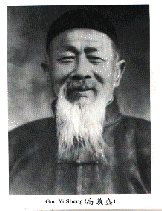
|
Internal Concepts |
Internal concepts are what set Taiji, Xingyi, and Bagua apart from other martial arts that you would normally come across in your local strip mall or industrial park. Most traditional martial arts focus on muscles to generate force whereas internal forms tend to focus more on how to use muscles to generate force that gets stored in the tendons and is then released. The idea of this is perhaps most famously demonstrated from the patriarch of Gao Style Bagua, Gao Yisheng. Being a man of small stature, Gao was unmatched in his fighting ability. His philosophy was simple, muscles are weak while tendons are strong. Using your muscles to store power in the tendons and releasing it all at once was his way of doing things and by doing so, cemented his name in martial arts forever.
|
|
*Moving while relaxed is easier and leads to faster movements since you are not fighting against your own muscle tension. Aside from these points, relaxing will allow you to stand in proper stances for keeping constant contact with the ground from your feet all the way to your hands. When these methods are combined, your strikes will gain the support that the ground provides. The importance of this will be explained in the next section. Right now, think of relaxation as the essential component that will tie together all internal principles explained here and grant you the level of speed and power that comes with the internal arts. |
| Ground path is probably a term you have not heard before today. That is, unless, you are already familiar with the internal arts. Otherwise, please continue reading.
To start this off, consider the infinite load-bearing potential of the ground beneath your feet. Every house, office building, gas station, and every other structure you see is held up through the integrity provided to its foundation by the ground beneath. Many who call themselves martial artists merely use the ground for standing upon and end up using their joints, bones, and muscles as the structure by which any variety of martial techniques are executed. For many, their bodies are built up to such a degree that every move executed against their opponent has sufficient power and support to deal a powerful blow. For everybody else who do not have the perfect physique most commonly associated with martial artists, and even those who want to try something different, utilizing a ground path can help to make up some of that difference in a shorter window of time. Being able to utilize this internal principle is dependent on both your relaxation and your ability to align your bones, joints, muscles, and tendons, which will be covered in the next section. In short, by standing with your feet shoulder-width apart, aligning your knees over your feet, bending your knees, and allowing your hips to move forward, you are already on the way towards achieving a full-body ground path that will extend from your feet all the way to your hands. When done correctly, you can let go of every ounce of tension in your body and you will remain standing. Learning to maintain and exploit a solid connection to the ground is perhaps the most fundamental practice in the internal arts. This principle has practical health beneits when practiced properly: better balance, reduced pressure on your joints, and improved balance are what one can expect from practicing internal principles. One simple daily workout that can be done to improve on these ideas is Eight Treasures from Tai Chi. Practice the following workout every day and you will see improvement in each of these areas.
|
|
Practicing stances every day is the ideal way to achieve this much-needed range of motion in the internal martial arts. In this section, you will be introduced to a number of stances considered essential to the internal martial arts, how to practice them both safely and effectively, as well as some pointers on how to get the most out of your practice. |
|
This practice is directly related to the ground path beginning with your feet and ending at your hands; the more forward and open your hips are, the better able you will be to maintain that direct contact with the ground. The principles behind this particular body alignment are to: |
|
. . [INSERT PAO CHUAN DEMONSTRATION VIDEO HERE] . . Likewise, in Pi Chuan, the first of the five Xingyi basic elements and Tsuan Chuan, the second of the five Xingyi basic elements, this torquing tension in the arms can be observed to playing more of a support role, acting to deflect or trap an opponent's limb, as demonstrated in these two basic elements' move set. . . [INSERT PHOTOS OF PI CHUAN AND PAO CHUAN DIRECTING A LIMB] . . Similar to Pao Chuan, Bemg Chuan, the third of the Xingyi basic elements, uses this torque in an offensive manner, namely delivering a direct punch forward while torquing the arm. Heng Chuan, the last of the five Xingyi basic elements, executes a mix of deflections, traps, and opportunities for strikes with seamless precision by utilizing this force in the tendons. |